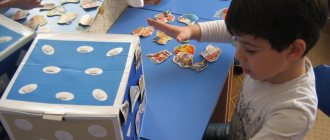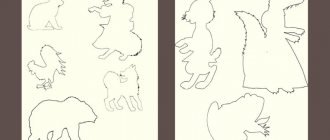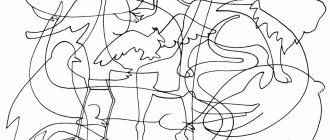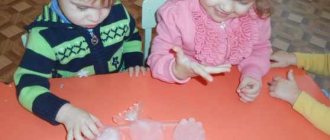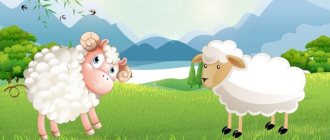Card index of creative games for preschool children
Card index of creative games
for younger ages.
«Toys at the doctor"
Target:
teach children how to care for the sick and use medical instruments, cultivate attentiveness and sensitivity in children, expand their vocabulary: introduce the concepts of “hospital”, “patient”, “treatment”, “medicines”, “temperature”, “hospital”.
Equipment:
dolls, toy animals, medical instruments: thermometer, syringe, pills, spoon, phonendoscope, cotton wool, jars of medicine, bandage, robe and doctor’s cap.
Progress of the game:
The teacher offers to play, a Doctor and a Nurse are selected, the rest of the children pick up toy animals and dolls and come to the clinic for an appointment. Patients with various diseases turn to the doctor: the bear has toothache because he ate a lot of sweets, the doll Masha pinched her finger in the door, etc. We clarify the actions: The doctor examines the patient, prescribes treatment for him, and the Nurse follows his instructions. Some patients require inpatient treatment and are admitted to hospital
"Building a house"
Target:
introduce children to construction professions, pay attention to the role of equipment that facilitates the work of builders, teach children how to build a simple structure, cultivate friendly relationships in a team, expand children’s knowledge about the peculiarities of the work of builders, expand children’s vocabulary: introduce the concepts of “construction”, “bricklayer” ", "crane", "builder", "crane operator", "carpenter", "welder", "building material".
Equipment:
large building material, cars, a crane, toys for playing with the building, pictures depicting people in the construction profession: mason, carpenter, crane operator, driver, etc.
Progress of the game:
The teacher invites the children to guess the riddle: “What kind of turret is there, and is there a light in the window? We live in this tower, and it's called...? (house)". The teacher invites the children to build a large, spacious house where toys can live. Children remember what construction professions there are, what people do at a construction site. They look at pictures of construction workers and talk about their responsibilities. Then the children agree to build a house. Roles are distributed among the children: some are Builders, they build a house; others are Drivers, they transport building materials to a construction site, one of the children is a Crane Operator. During construction, attention should be paid to the relationships between children.
"Stepashka's Birthday"
Target:
expand children's knowledge about the methods and sequence of table setting for a festive dinner; consolidate knowledge about cutlery, cultivate attentiveness, caring, responsibility, desire to help; expand your vocabulary: introduce the concepts of “celebratory dinner”, “name day”, “serving”, “dishes”, “service”.
Equipment:
toys that can come to visit Stepashka, tableware - plates, forks, spoons, knives, cups, saucers, napkins, tablecloth, table, chairs.
Progress of the game:
The teacher informs the children that today is Stepashka’s birthday and offers to go visit him and congratulate him. The children take their toys, go to visit Stepashka and congratulate him. Stepashka offers everyone tea and cake and asks them to help him set the table. Children actively participate in this and, with the help of the teacher, set the table. during the game
"Let's go for a walk"
Target:
develop in children the ability to select clothes for different seasons, teach them to correctly name items of clothing, consolidate the general concepts of “clothing”, “shoes”, and cultivate a caring attitude towards others.
Equipment: dolls, clothes for all seasons (summer, winter, spring and autumn, a small wardrobe and a chair.
Progress of the game:
A new doll comes to visit the children. She meets them and wants to play. But the guys are going for a walk and invite the doll to go with them. The doll complains that she can’t get dressed, and then the guys offer her their help. Children take out doll clothes from the locker, name them, choose what they need to wear now depending on the weather. With the help of the teacher, they dress the doll in the correct sequence. Then the children dress themselves and go out for a walk with the doll. Upon returning from a walk, the children undress themselves and undress the doll in the required sequence, commenting on their actions
"Doll's Birthday"
Goals : introduce children to the rules of table setting, table manners, and tableware; teach how to correctly find and select utensils for tea drinking;
continue to enrich the content of games; promote the unification of children for joint games; enrich vocabulary; cultivate a desire to observe norms of behavior at the table, respectful attitude towards each other.
Equipment: teaware, tablecloth, doll in an elegant dress, figurative toys (bear, hare, barrel of honey, carrot. You can use substitute items.
Progress of the game:
The teacher says that today is Katya’s doll’s birthday and she invites you to visit. Advises the children to think about what they will give Katya, how they will please her. He suggests that they can come to visit with a bear and bring a barrel of honey or with a bunny who will give Katya a delicious sweet carrot.
Then the teacher invites the children to help Katya beautifully set the table for the guests and prepare tea.
Children are going to a birthday party.
When repeating the game, you can celebrate the birthday of a bear, bunny, cat, etc.
Card index of creative games for middle-aged children.
Zoo
Target:
expand children's knowledge about wild animals, their habits, lifestyle, nutrition, cultivate love and humane attitude towards animals, expand children's vocabulary.
Equipment:
toy wild animals familiar to children, cages (made of building material), tickets, money, cash register.
Progress of the game
: The teacher tells the children that a zoo has arrived in town and offers to go there. Children buy tickets at the box office and go to the zoo. There they look at the animals, talk about where they live and what they eat. During the game, children should pay attention to how to treat animals and how to care for them.
Target:
introduce children to construction professions, pay attention to the role of equipment that facilitates the work of builders, teach children how to build a simple structure, cultivate friendly relationships in a team, expand children’s knowledge about the peculiarities of the work of builders, expand children’s vocabulary: introduce the concepts of “construction”, “bricklayer” ", "crane", "builder", "crane operator", "carpenter", "welder", "building material".
We are building a house
Equipment:
large building material, cars, a crane, toys for playing with the building, pictures depicting people in the construction profession: mason, carpenter, crane operator, driver, etc.
Progress of the game
: The teacher invites the children to guess the riddle: “What kind of turret is there, and is there a light in the window? We live in this tower, and it's called...? (house)". The teacher invites the children to build a large, spacious house where toys can live. Children remember what construction professions there are, what people do at a construction site. They look at pictures of construction workers and talk about their responsibilities. Then the children agree to build a house. Roles are distributed among the children: some are Builders, they build a house; others are Drivers, they transport building materials to a construction site, one of the children is a Crane Operator. During construction, attention should be paid to the relationships between children. The house is ready and new residents can move in. Children play independently.
Kindergarten
Target:
to expand children’s knowledge about the purpose of a kindergarten, about the professions of those people who work here - a teacher, a nanny, a cook, a music worker, to instill in children a desire to imitate the actions of adults, and to treat their pupils with care.
Equipment:
all the toys you need to play in kindergarten.
Progress of the game:
The teacher invites the children to play in kindergarten. If desired, we assign children to the roles of Educator, Nanny, Music Director. Dolls and animals act as pupils. During the game, they monitor relationships with children and help them find a way out of difficult situations.
Shop
Target:
teach children to classify objects according to common characteristics, cultivate a sense of mutual assistance, expand children’s vocabulary: introduce the concepts of “toys”, “furniture”, “food”, “dishes”.
Equipment:
all toys depicting goods that can be bought in a store, located on the display window, are money.
Progress of the game
: The teacher invites the children to place a huge supermarket in a convenient place with departments such as vegetable, grocery, dairy, bakery and others where customers will go. Children independently distribute the roles of sellers, cashiers, sales workers in departments, sort goods into departments - groceries, fish, bakery products, meat, milk, household chemicals, etc. They come to the supermarket for shopping with their friends, choose a product, consult with sellers, pay at the cash register. During the game, the teacher needs to pay attention to the relationship between sellers and buyers. The older the children, the more departments and products there may be in the supermarket.
At the doctor's
Target
: teach children how to care for the sick and use medical instruments, cultivate attentiveness and sensitivity in children, expand their vocabulary: introduce the concepts of “hospital”, “patient”, “treatment”, “medicines”, “temperature”, “hospital”.
Equipment
: dolls, toy animals, medical instruments: thermometer, syringe, pills, spoon, phonendoscope, cotton wool, jars of medicine, bandage, robe and doctor’s cap.
Progress of the game
: the teacher offers to play, a Doctor and a Nurse are selected, the rest of the children pick up toy animals and dolls, and come to the clinic for an appointment. Patients with various diseases turn to the doctor: the bear has toothache because he ate a lot of sweets, the doll Masha pinched her finger in the door, etc. We clarify the actions: The doctor examines the patient, prescribes treatment for him, and the Nurse follows his instructions. Some patients require inpatient treatment and are admitted to the hospital. Children of older preschool age can choose several different specialists - a therapist, an ophthalmologist, a surgeon and other doctors known to children. When they get to the appointment, the toys tell them why they came to the doctor, the teacher discusses with the children whether this could have been avoided, and says that they need to take more care of their health. During the game, children watch how the doctor treats the sick - makes bandages, measures the temperature. The teacher evaluates how children communicate with each other.
Creative games for older kindergarten children
"Kindergarten".
Target:
Consolidating children's knowledge about the work of a nurse and doctor, laundress, cook, janitor and other kindergarten workers. Fostering interest and respect for their work. Developing in children a sense of gratitude for the work of adults for them, a desire to provide them with all possible help. Development of the ability to apply acquired knowledge in collective creative play.
Subject development environment (equipment):
Dolls, toy dishes, Doctor set, toy telephone, substitute items.
Preparing for the game.
Excursion to the doctor's office. Introducing attributes for organizing the game of “children’s doctor”. Reading the story “Our Doctor” by A. Kardashova. Observation of the work of a laundress. Organization of children's work - washing doll clothes. A tour of the kitchen. Lesson “Let’s bake buns for ourselves and the kids.” Modeling products for playing “cook”. Conversation “Who works in our kindergarten and how.” Drawing on this topic. Introducing attributes for organizing a collective game in the “kindergarten”.
Game roles.
Doctor, nurse, teacher, manager, music worker, assistant teacher (nanny), cook.
Progress of the game.
Before the game starts, the teacher carries out preliminary work. Together with the children, they visit the medical office, the kitchen, the laundry room, the rhythm room, the manager’s office and talk with the nurse and doctor, cook, laundress, and manager about their work.
After this, the teacher conducts a conversation in the group “Who works in our kindergarten and how”, and summarizes the knowledge gained on the excursion. Then you can play the game “Daily Routine” with the children, thereby outlining a game plan. You can also read stories and poems about kindergarten with your children and prepare the necessary attributes for the game: instruments for the doctor, doll dishes, etc. Next, the teacher can invite the children to play on their own, if the children have not yet developed a proper interest in the game, The teacher can act in the game as an equal partner, playing a major or minor role, indirectly influencing changes in the game environment, he can correct the game relationships. For example, he can offer children the following roles: “doctor”, “nurse”, “teacher”, “manager”, “music worker”, “teacher’s assistant”, “cook”. When all the roles have been distributed, the teacher encourages the children to play: “Now you need to do exercises with the dolls, then sit them down to have breakfast.” “Nanny needs to quickly go to the kitchen and bring breakfast.” “After breakfast, you need to go for a check-up with a doctor.” After breakfast, the “doctor” and “nurse” carefully examine the “children” and give each one recommendations. One child is sick and the “teacher” needs to call the parents on the phone: “Your daughter is sick, she needs to be picked up from kindergarten.” After a medical examination, the “children” need to go to a “music lesson,” etc. As the game progresses, the teacher monitors the correct development of the plot, smoothes out emerging conflicts, advises what else can be invented, and introduces new roles for the children if they wish.
Game "School".
Target.
Formation of the ability to creatively develop the plot of the game. Teaching children to fairly distribute roles in games. Encouraging children to reproduce in games the everyday and socially useful work of adults.
Subject development environment (equipment):
Dolls, furniture, building materials, play attributes (magazine, notebooks, pens, pencils), substitute items.
Preparing for the game.
Excursion to school. Conversation with a 1st grade teacher. Reading the works of L. Voronkova “Girlfriends Go to School” or E. Moshkovskaya “We Play School” and others. Joint games with children of the preparatory group.
Game roles
. Teacher, students.
Progress of the game.
Before the game starts, the teacher organizes a tour of the school. There the children meet teachers, schoolchildren, and talk with them. It is also necessary to take the children around the entire school: show them the classrooms, canteen, workshops, locker room, etc. Then, in a group, discuss their impressions of the school. Then, to further enrich knowledge about school, the teacher reads to the children the work of L. Voronkova “Girlfriends Go to School” (or E. Moshkovskaya “We Play School”, etc.). This is followed by a conversation about what it means to be a schoolchild, who teaches the lesson, what supplies the student has, etc. The teacher also helps children in mastering expressive means of playing a role (intonation, facial expressions, gestures). Together with the children, the teacher can make attributes for the game: a magazine for the teacher, headbands for the attendants, etc. During the game, when constructing a school building or classroom, the teacher develops the design creativity and ingenuity of children, encourages the construction of interconnected buildings (street, school, cultural park , bridge, underground passage); proposes to use auxiliary materials in buildings (cords, pegs, planks, cones, wire, etc.). The methods of managing this game are different: the teacher plays the role of “teacher”, talks with children about how they will play, joint construction of a school or class. The use of such techniques promotes children’s independent organization of games, where they act in accordance with their selective interests (conduct reading, physical education, and mathematics lessons). Acting as an equal partner or playing a major (minor) role, the teacher must indirectly influence changes in the gaming environment and correct gaming relationships. The teacher should also facilitate the reproduction of everyday and socially useful work of adults in games. To consolidate knowledge of the Rules of the Road (the road from home to school and back), to combine games that are similar in theme, creating the possibility of long-term collective games: “Family” - “School” - “Road to school” - “Trip around the city”.
Game "Atelier" House of Fashion"
Goals:
To develop the ability of children to divide into subgroups in accordance with the plot and, at the end of a given game action, to unite again into a single team. To cultivate respect for the work of a seamstress, fashion designer, cutter, to expand the idea that their work is collective, that the quality of the work of another depends on the conscientious work of one person. Develop the ability to apply knowledge of measurement methods in the game. Develop children's dialogical speech.
Example game actions:
· selection and discussion of the model with the fashion designer, selection of material;
· cutters take measurements and make a pattern; the receptionist places the order, determines the deadline for completing the order;
· the seamstress fulfills the order, tries on the product;
· the head of the studio monitors the execution of the order, resolves conflict situations when they arise;
· the cashier receives money for a completed order;
· Delivery service may be available.
Subject development environment (equipment):
sewing machines, fashion magazine, sewing tools (cm, threads, fabric samples, etc.), accessories, patterns, order forms, “mannequins”.
Both bad and good
Typically, children evaluate what is happening in two categories - “good” and “bad”. Invite him to evaluate unpleasant situations in life using these categories, let him find the positive in the situation. They lost a backpack with toys - now he has become more attentive and the parents will buy a new beautiful backpack. We were sick at home for a week, but we trained our immunity and also read four thick books. We arrived at the seaside, and it was raining there - we went to the cinema, rode horses.
We, adult optimists, are accustomed to seeing positive moments, but children should be trained in this.
Didactic games in fine arts in the middle group
For older children, offer games to develop color vision and imagination, the ability to understand the mood of a picture, compose figures and patterns in compliance with symmetry and spatial relationships.
Cheerful caterpillar
Make circles in different shades. Tasks for children - to make caterpillars from circles in different variations:
- from dark to light shades;
- from cold to warm.
Colorful arithmetic
The circles used for the previous game can be used for another activity that develops color perception. Additionally, draw arithmetic signs: plus, minus, equal. Make the circles in different ways, and the students must guess what shade they will get.
For example:
- red + yellow = orange;
- green – yellow = blue;
- blue + white = light blue.
Palette
Paint the seasons using 4 separate palettes. Place landscapes (autumn, winter, spring, summer) in front of the students. Showcase the palettes you used. The task is to determine by the combination of colors what palette each landscape was painted with.
Bunny
The game develops imagination. Children learn schematic representations of living beings.
For this lesson you will need ovals of different sizes and elongations cut out of cardboard. Invite the players to create a bunny standing on its hind legs from the available figures. If desired, let the children try to place other animals.
Decorate your mitten
The game teaches how to create patterns taking into account spatial relationships and symmetry. Place a mitten cut out of paper and a set of geometric shapes in front of your child. The task is to create a beautiful and symmetrical pattern.
Playing in visual arts can instill the skill of cooperation and interaction. To do this, divide the kindergarteners into pairs and distribute mittens: one with the right one, the other with the left. Let them try to make the same patterns.
Plasticine vase
Let the child connect 2-3 small pieces of plasticine of different shades and knead them well to obtain streaks reminiscent of marble. From the resulting mass he will fashion a vase.
Magic palette
The game develops the perception of the colors of the surrounding world and an emotional response to the beauty of nature.
Give participants square colored cards. Name a natural object. Children must remember how it is colored and pick up the corresponding cards. For example, with the word “birch”, white, black, green squares should be raised. When you hear the word “chamomile” – yellow, white, green. The participant who picks up the wrong card is eliminated.
Painted horses
The game reinforces the idea of the main types of Russian folk paintings.
Prepare painted horses and images of four pastures called “Gzhel”, “Dymka”, “Gorodets”, “Filimonovo”. The child must say what painting each figurine is decorated with and place it in the corresponding pasture.
Artistic constructor
Distribute pencils and sheets of paper with outlines of simple shapes to the students. Offer to complete the images to create recognizable objects.
Didactic games in fine arts in the preparatory group
When preparing kindergarteners for school, it is important to teach them to describe pictures and their feelings from what they see, to show imagination in everyday life, and to be attentive and observant.
Guess the picture
For the game, prepare reproductions of paintings familiar to kindergarteners. Describe each image verbally and let the children guess what it is about. For example: “In a bright room, a girl in a pink jacket is sitting at a table, she has a fruit in her hands” - this is “Girl with Peaches” by Valentin Serov. Or: “A mother bear and three cubs are frolicking on fallen trees in the middle of a pine forest” - this is “Morning in a Pine Forest” by Ivan Shishkin.
Guess by profile
Prepare recognizable contour profiles of fairy-tale characters: Baba Yaga, Kashchei, the Little Humpbacked Horse, the Serpent Gorynych and others. Children must guess who is pictured.
What does the painting smell like?
Show your students reproductions of paintings. Let them imagine what smells they will smell when they suddenly find themselves inside the painting.
How does the picture sound?
The game is similar to the previous one, only here they imagine not by smell, but by hearing. Let the children imagine what sounds they will hear when they are inside the painting.
What do clouds look like?
If the weather and sky conditions permit, take the group for a walk. If not, find beautiful photos of cumulus clouds. Invite students to imagine what they look like. Emphasize that clouds come in different shapes and sizes.
What's missing?
Show the children some reproductions of famous paintings. Cover up any detail in the images. Show the pictures again and ask them to remember which element is hidden.
Portrait of a neighbor
The game teaches you to correctly and correctly describe a person.
Give participants cardboard frames. Let everyone, bringing the frame closer to their neighbor’s face, try to create a verbal portrait of him.
Diagnostics of gaming activity
Educational activities in kindergarten are carefully analyzed. Moreover, the analysis of the components of the educational process is carried out by the teacher himself, methodologists and colleagues. Self-analysis is necessary to identify and correct shortcomings in the organization and conduct of games, and third-party commentary is needed to draw up an overall assessment of the teacher’s competence in organizing the educational process. If we talk about a general assessment of the play activity of children in a group, then the teacher prepares such a report at the beginning and end of the school year. To do this, he uses an algorithm, which can be seen here https://yadi.sk/i/h9xM3BE53SLSwU
Since the child plays not only in preschool, but also at home, parents are involved in the analysis of the child’s play activity. The analysis scheme in the form of a questionnaire for moms and dads can be found here https://yadi.sk/i/K5T4siNu3SLSwk
To formulate conclusions regarding the level of development of the child’s play activity, the teacher uses the results obtained, describing them in free form based on the data obtained.
Diagnostics of gaming activity, among other things, helps determine how quickly children get involved in the game
Play activity is the leading activity for a child in the preschool period. That is why all elements of the educational process in preschool educational institutions fit into the game form. This makes it possible to realize a wide range of goals and objectives in preparing children 6–7 years old for the next stage of education—school. At the same time, the responsibility for choosing the content and form of the game, as well as preparing, conducting the fun and drawing up diagnostic cards for the level of development of gaming activity falls on the shoulders of the teacher.
Didactic games in fine arts in the senior group
In classes with older preschoolers, it is worth paying attention to the emotional side of fine art, developing an understanding of the genres of painting, and developing the skill of constructing a composition.
Draw a portrait
To play, draw 4-5 portraits depicting human emotions: joy, fear, surprise, sadness, anger. Cut the images into 3 parts: forehead and eyes, nose, mouth and chin. For clarity, show several famous painting portraits. Explain what genre this is. Invite participants to become artists and create portraits with different emotions from parts of the face.
Make up a landscape
Place cards on the table depicting various objects of the surrounding world. Ask to choose those from which you can make a landscape.
Collect a still life
Cut out pictures of fruits, vegetables, berries, flowers, mushrooms, vases, baskets, jugs. Ask the children to create a beautiful still life.
Happy or sad
Like the didactic game “Artist,” this activity teaches you to correlate mood with palette.
As visual material, use realistic illustrations from books and reproductions of famous paintings. Show the image to your students and ask them to determine what mood it conveys and why. Children should explain that fun is reflected in bright, rich, light colors, and sadness is reflected in dull, dark, dull colors.
Sea
The game teaches you how to build an artistic composition and develops logical thinking.
Prepare a picture of an empty sea with a background of seaweed and a sandy bottom. Separately depict underwater inhabitants: fish, snails, shells, dolphin, whale, seahorse and others. Explain to the participants that the sea inhabitants hid. To see them, you need to solve riddles. A child who correctly guesses a living creature attaches its picture to the underwater landscape.
What will happen?
Place a piece of paper and pencils in front of the players. Children take turns drawing. One draws a line and gives the sheet to the other participant. He continues the drawing with the second line and passes the baton. And so on until the drawing is ready. At the end, everyone looks at what happened.
What doesn't happen?
Offer kindergarteners a game to develop their imagination. Let them draw something that does not exist. Each participant demonstrates his creation and explains what he depicted. The others discuss whether there really is no such object in the world.


